Since time immemorial Old Delhi has been the hub of royals and nobles, writers and artists, traders and adventurers. It has given shelter to many with open arms, and embraced visitors so warmly that they have made it their home.
This old part of the national capital has seen many ups and downs. It was here that Shahjahan, the Mughal emperor, laid the foundation of Shahajanabad – which survives even today. It also witnessed the carnage by Nadir Shah in 1739, which he watched from atop the Sunehri Masjid. Old Delhi also saw the end of the Mughal empire, when the British wiped out all resistance from the streets of Old Delhi.
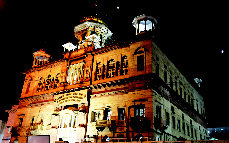
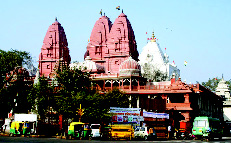
Shish Ganj Gurudwara, Chandni Chowk Jain Mandir/Bird Hospital
Friday Gurgaon takes you on a trip down memory lane, to Purani Delhi – but with a twist. Instead of visiting the traditional ‘tourist’ spots (like Jama Masjid), we shall smell the lanes and by-lanes of Purani Dilli – that have endless tales to tell, and every brick speaks its own story. While Chandni Chowk is the traditional hub of Purani Delhi, with the majestic Lal Qila overlooking it, we decide to start our journey at Chawri Bazar. Luckily, the Metro network has made it very easy for us Gurgaonites to visit both the Old and the New Delhi.
At just 11 in the morning Chawri Bazar, the hub of wholesale trade in paper, is brimming with people. The Metro station is a marvel in itself, as it is deep underground – you have to take 5 elevators to reach the surface. As soon as you get out, you are hit by the cacophony of traders, chaiwallahs, fruitwallahs, and several street vendors sitting on the pavement.
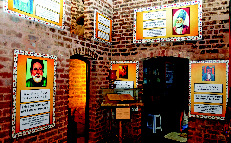

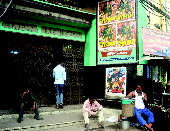
Mirza Ghalib Haveli, Ballimaran Sultan Raziyaís Tomb Cinema Excelsior, near Lal Kuan
On one side is the famous Bazar Sita Ram, which has been the traditional hub of Hindu Banias; and on the other side is the Bazar Sirkiwalan, famous for the traditional sirkis, that were used in tying the Purdahs. This Bazar has now become a hub of steel utensils, machines used in restaurants, frames to make ice-cream, and much more. We take a walk through the Bazar, as it also leads to Ballimaran, that was home to one of the greatest poets of Urdu, Mirza Ghalib.
Walking is a difficult task, and it is better you take the rickshaw. Just 200 metres into Sirkiwalan, and we spot the famous shop of Bade Mian Kheerwale, that has been selling this sweet for more than 100 years in this simple shop. Bade Mian’s owner, Jamaluddin Siddiqui, says that his family used to have buffaloes; once, his great grandmother cooked the excess milk into a kheer, and it was sold within hours. And so was born ‘Kheerwale’. “We have been selling the kheer since 1880, and have numerous patrons. What brings them back is the same taste and quality, year after year,” says Mian. The brownish coloured kheer melts in the mouth, and visitors would do well to order the small plate, as it sits heavy.
Tilak Raj, a resident of Old Delhi, and a Producer with Doordarshan, says that traditional culture and food still lives in some parts of the Old city, as it has not fallen prey to ‘commercialisation’. “Old Delhi represents individuality, respect for elders, living in peace with each other, and cultural sophistication. These traits are still visible in parts of Purani Delhi,” claims Tilak Raj, while admitting that it was partition that literally jolted life here.
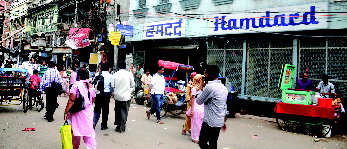
Hamdard Shafakhana
After shaking hands and saying goodbyes as if we are old friends, we move ahead and spot the Excelsior Theatre. A Nawab was once the proud owner of this now decrepit theatre. Bade Mian had told us that the family of the Nawab is facing penury, as his two sons have expired and only ladies in the families are left behind. This perhaps is the story of many Nawab and Zamindar families, who could not move with the times.
But we keep on moving, and reach the famous Hamdard Shafakhana. Bang opposite is Ballimaran - the colony of the oarsmen, who rowed the boats in the Yamuna during the Mughal times.
This area was once the hub of culture, writing and art; it was frequented by the leading nobles and was home to men of literature. There has been many a midnight soiree in these parts. The most illustrious inhabitant was Ghalib, who lived in a Haveli that was once owned by the Nawab of Loharu – in Gali Qasim Jan. Ghalib had in fact married the sister of Nawab Umrao Begum, as per the family tree shown in the ASI protected monument. This monument is worth a visit, although major portions of the Haveli have been built by the present owner Fakhruddin. A couple of years ago the government bought a portion of the Haveli, and dedicated it to Mirza Ghalib.
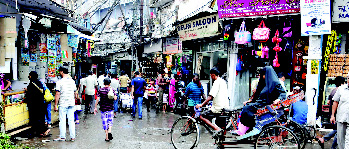
Inside Chawri Bazar
Fakhruddin, who sits at the gate, as if waiting for the Mirza to come back, says that the last 9 years of the poet’s life were spent here in pain and penury. “We are proud to be a part of history. Not only Ghalib, but many other nobles and great men of their time have lived in Ballimaran,” says Fakhruddin. Ballimaran has a large population of silver leaf workers, who hammer this metal into thin leaves, to be used as ‘warq’. Nearby also is the shoe market, that sells some of the cheapest handmade shoes in the entire City.
After embracing the endless tales and history of Ballimaran, we decide to have tea; and not surprisingly this part of the City has a different take to it. In Old Delhi, particularly in the Muslim area, tea is brewed constantly, milk is heated separately, and it is only after the order comes that the two are mixed. People here prefer very sweet tea, that too ‘malai maar ke’.
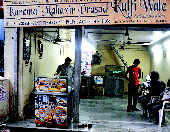
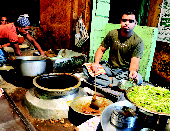
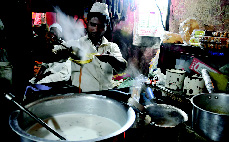
Kuremal Kulfi Wala, Sita Ram Bazar Nehari (Non-veg dish), Bulbuli Khana Chai Wala
Ballimaran also has a number of Kebab sellers, and Muinuddin Kebab Wala—who comes at 8 pm every day—is the toast of the 'town'. Mohd. Yunus, a resident of the area, says that he has been to very few shops and hotels that sell such tasty and succulent Kebabs. “Meri saari family like karti hai, aur ham hafte main ek baar zaroor aate hain. Gurgaon wale bhi khaneke bahut shokeen hain, unhe yahan ke baare mein batao,” he says.
As we move out of Ballimaran, we take a right to Lal Quan, where the palace of Bahadur Shah Zafar’s favourite queen, Zeenat Mahal, was located. The gateway of the palace, which once would have been the diamond in the crown of this area, is in tatters. It has been converted into a commercial area, with numerous wholesale shops. The real story, however, unfolds behind the gates – where the entire Zeenat Mahal has been razed to the ground, and a modern 21st century building stands tall. This is a school for girls – no doubt badly needed in this area. The palace was witness to some very important moments of Indian history.
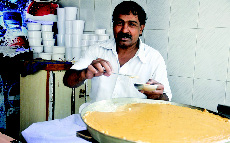
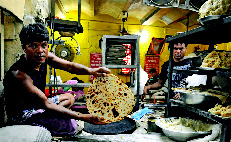
Bade Mian Kheerwale Kake di Hatti, Chandni Chowk
We decide to savour the famous chaats that this part of the City offers. It is the time to mix history with pleasure, and unravel old Delhi plate by plate. There is a huge crowd at Ashok Chatwala. There is an aroma of alu tikkis, and the colourful collage of large alus and golgappas looks great. Ajay Agarwal, a resident of the Walled City, tells us to explore Chawri Bazar, if we want to taste the real purani Delhi. We spot Hira Lal Chaat corner, that sells Kulle, a Chaat that has been made by scooping a tomato, a banana or cucumber, and filling it with spices, chick peas and masalas. It is a great appetizer. We also explore Raghuganj, where Anil Kumar Jain and his family have been making delightful fruit sandwiches since 1958. These sandwiches are something else – to be savoured only in the lanes and bylanes of Old Delhi, where the old meets the new seamlessly.
Next door is Bazar Sita Ram, which also houses the historic Kucha Pati Ram. The Haksar Haveli, owned by the in-laws of Pandit Jawahar Lal Nehru, still stands in this traditional Hindu area dominated by Banias. The area is now a manufacturing and wholesale hub. Ashok Gupta, brother of the famous television actress Neena Gupta, says that many business families lived in this area in the past, but now the young generation is leaving the Old City due to the paucity of green areas and parking space. “The younger generation wants to move out, as they see new avenues of jobs and a better lifestyle. However, there are still thousands of families who are strongly rooted here, and continue to live in peace and brotherhood. Every street has its own temple, and traditional Hindu festivals are celebrated in style here,” he asserts. "Before leaving, do not forget to savour a Kulfi from Kure Mal Kulfiwala."
On to Bulbuli Khana, a predominantly Muslim area near Turkman Gate, which perhaps takes its name from the numerous Bulbuls that dominated the area. Bulbuli Khana is the place where the mausoleum of the first woman emperor of India, Razia Sultana, is located. Her sister, Shazia Begum, is said to be buried along with her, though some say that it is her associate Yakut.
Maulana Hafiz Tauheed Alam, who is tending the mosque, says that the Mehrab in the wall—that is equidistant from the sides of the walls—has been built in such a manner that this structure could be used as a mosque. “In reality, whosoever delivers the prayers here benefits the dead who have been buried here, because the prayers also work for those in the other world,” says the Maulana. This mosque is 950 years old, and it looks that it go on for another 1000 years – such is the strength and simplicity of this construction.
As we move out of the mosque, the Maulana tells us to visit Chitli Kabar; to reach there we will have to cross the Pahari Bojhilla, that was once the chosen haunt of Bojhilla dacoit, who had terrorised the inhabitants of Old Delhi, says the local lore. Chitli Kabar has the mausoleum of Khwaja Mujibuddin Chishti, a close relative of the Ajmer based Chishtis. The streets in the area are sometimes not more that 2 feet wide, and it seems every house has a handicraft factory. Shahid, an artisan who allows us inside his shop as it has started pouring, says that this area is famous for leather artefacts, bead work, and traditional Chitli work that is done on metal utensils.
There are a large number of shops selling utensils. A particular Paan Dan catches our fancy, and we ask the shopkeeper its price. “The price is Rs. 2,800, and it is a piece of art. There are a large number of people who still buy these Paan Dans, as eating Paan is part of our culture,” says Jagmohan Malhotra, who has been selling his wares to Muslim families for several years. A large number of foreigners also throng the lanes and by-lanes of Old Delhi to buy these utensils, he says. No doubt Paans are popular here, as a large number of shops in the area sell betelnuts, tambaku and kaththa in different shapes and sizes. Such scenes can not be seen normally in our malls, where ‘sanitised’ goods are kept under video surveillance, and customers normally don’t have the time to touch and feel.
Here you can touch and feel, and even then can refuse to buy. Ten rupees still has ‘respect’, as a Seekh of Kebabs can be bought for this amount in Chitli Kabar. Don’t also miss the Sutli Kebabs, that are so soft that they have to be held with fine strings. Mota Biryani Wala is another traditional stoppage for the foodie. Danish, a resident of Dariyaganj, says that he has been eating the biryani for the last several years, and never has been the combination of meat and rice so perfect. “The Mughals will also be delighted if they come here,” he laughs. Just ahead is Sheeren Sweets, a shop that sells mouth-watering ice cream, Phirni, and Shahi Tukda.
From Chitli Qabar we move to the Jama Masjid, Gate No. 2, and on our way we find numerous shops selling biryani, meats, fish, sweets, Pakistani dresses – and one shop keeper even claimed to be selling original Peshawari chappals from Pakistan. We also spot a documentary film team, trying to film amid the chaos on the street.
While moving out of the area we see a shop filled with green fodder, and lines of people buying it. It kicks our curiousity bug, and we ask the shopkeeper what this is all about; the answer surprises us. Old Delhi has almost 20,000 sheep and goats that are kept by the residents for sacrifice – and need to be fed.
We take leave of this part of the City and move out towards Jama Masjid, where the famous Meena Bazar is filled with shoppers and tourists. Once upon a time the adjacent Bazar was called Urdu Bazar, and it was the cultural hub of Delhi – with Urdu language at its prime. Rashid, an 82 year old artist, says that those days are gone now, and this area is known more for meat shops and other eateries. “The partition destroyed everything. I witnessed the carnage, and I am proud to say today that Muslims in India are a hundred times better off than their counterparts in Pakistan,” says Rashid; adding “please write this categorically”.
Tej Prakash Sharma, Manager of Shri Gauri Shankar Mandir, that is almost 8 centuries old, says, “This Temple was was first set up in a temporary structure. It was later formally built by Gangadhar, a Maharashtrian Brahmin who was a friend of Shahjahan. It came up only after Lord Shiva saved the emperor from a great enemy. Once the emperor asked the bells to be removed, as he could not sleep properly. But despite that, he could not sleep, so he asked his men to check again. They reported the removal of the bells, but the king still heard the sounds, and realised that some special power was behind all the sound in his mind,” says Sharma – adding that after that the bells were never removed.
At the corner of Chandni Chowk is a famous Jain temple, that also houses the famous bird temple. Situated just opposite the Red Fort, the Temple was founded in 1656, during the reign of Shahjahan. It was only after independence that it was extensively rebuilt, and is now one of the most beautiful buildings abutting the road. The bird hospital in the temple houses 2,000 birds; they are treated, and then released when they are fit.
A visit to Chandni Chowk is incomplete without paying obeisance at the Gurudwara Sis Ganj Sahib. It was here that the great Sikh Guru Tegh Bahadur sacrificed his life, for refusing to embrace Islam. In 1783, a Sikh General Baghel Singh laid the foundation stone; but it remained disputed till 1930s. There is also the famous Sunehri Masjid, and the Central Baptist Church, on this road – standing close to each other. “We live in complete harmony,” says Sharma.
Chandni Chowk of course has a number of shopping hubs, like Dariba Kalan – famous for gold and silver jewellery, the Gota and Kinari Bazar, and the numerous Katras selling clothes, suits and dresses to people from all across the world. Some famous eateries in this area include the Jalebiwala, who sells hot and mouthwatering Jalebis close to Dariba; Kishan Lal Halwai, who comes every evening to sell his mouth-watering ware, just opposite the Chabra 555 shop on the main road. One can also take a detour to Paranthe wali galli. We decide to visit Kake di Hatti, whose freshly baked naans cannot be missed by any connoisseur. We order Alu Pyaaz Nan – one large Naan is enough for two. And finally, to Gianis, for Falooda Kulfi, as the last stop in our itinerary. The charm of Old Delhi has sucked us deeper and deeper into its magical lanes. It is time to break out of this reverie—of Bade Mian’s Kheer and Sutli Kababs, the tales of the nawabs, sultans, Mughals, and the slaves—and take the Metro back to the Millennium City.
Read More...